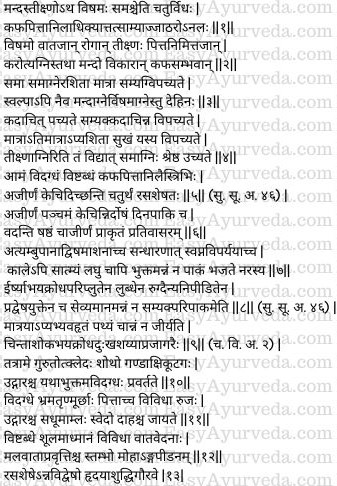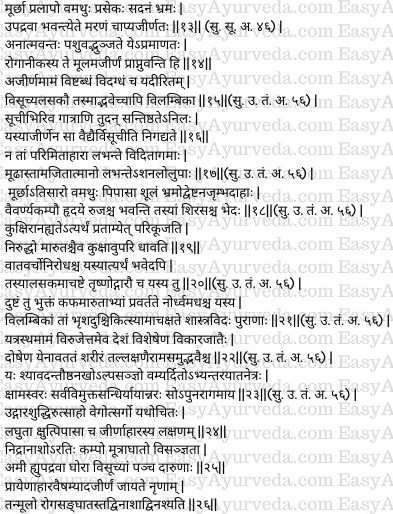Madhava Nidana Chapter 6 Agnimandya Ajeerna Visuchika Alasaka Vilambika Nidana
This article explains Madava nidaana 6th chapter “Agnimandya Ajeerna Visuhika Alasaka Vilambika Nidanam”. These are a set of digestive disorders.
Read – Acharya Madhavakara: His Work ‘Madhava Nidana’, Legacy, Amazing Facts

Table of Contents
Jatharagni Types
Kinds of Jatharagni – digestive fire
The jatharaagni (gastric fire, digestive activity) is of four kinds, they are –
- Mandagni (manda agni) – caused due to predominance of kapha
- Tiksnagni (tiksna agni) – caused due to predominance of pitta
- Visamagni (visama agni) – caused due to predominance of vata
- Samagni (sama agni) – caused due to the normalcy of all the three doshas
Read – Understanding Agni: Concept, Definition, Functions, Types
Behaviour and functions of different kinds of agni
1. Mandagni – This type of agni dominated by kapha either partially digests the food (to a small extent) or is incapable of digesting even a small quantity of food. This type of agni causes kapha diseases.
2. Tikşngaani – This type of agni dominated by pitta digests the usual or even excess quantity of food without any difficulty. This agni is powerful and can digest the food within a short span of time. This type of agni causes pitta diseases.
3. Visamaagni – This type of agni dominated by vata sometimes digests the food properly and sometimes improperly. This erratic and fluctuant behaviour of the agni is due to the influence of vata. This type of agni causes vata diseases.
4. Samāgni – This type of agni is due to normalcy and balance of all the three doshas i.e., vata, pitta and kapha. This is a healthy state of digestive activity. This kind of agni digests the normal quantity of food without causing any difficulty,
Among these 4 kinds of agni, only samāgni is said to be ideal for good health. (2-4)
Read – Jataragni and Kayagni: Differences, Easy Understanding
Types of Ajirna- Indigestion
There are basically three kinds of ajirna (indigestion) caused due to the predominance of one or the other type of dosha in each type. They are –
Ama ajeerņa – caused by kapha excess
Vidagdha ajeerņa – caused by pitta excess
Vistabdha ajeerņa – caused by vata excess
Other types of ajeerņa
- Rasasesa ajeerna – Others include a fourth one the rasasesa ajīrna as fourth type of ajīrņa. This type of indigestion is related to āhāra rasa (indigestion on a nutrient portion of food).
- Dinapāki ajeerņa – According to some others the fifth type of ajīrņa is dinapāki ajīrņa. In this type of indigestion, the food is digested the next day but without causing any difficulty (delayed digestion).
- Prativasara ajeerņa – Yet others consider prativasara ajirna as the sixth type of ajirņa. This type of indigestion is found every day, normally, immediately after taking the food i.e. until the taken food is digested. This is a normal state and the indigestion is temporary and not pathological. It goes away once the food is digested. (5-6)
Read – Understanding Digestion Process From An Ayurveda View
Nidana
Nidana – etiological factors of ajīrņa (indigestion)
The general causes of indigestion include drinking water in large quantities, taking large or small quantities of food at unusual times, suppression of natural urges of the body, erratic sleep patterns i.e., not sleeping during night times and excessive sleeping during daytime. These factors cause indigestion of food in spite of the person taking – normal quantity of food, foods which have been accustomed and foods at proper time.
Food does not get digested properly in a person who is afflicted with jealousy, fear, anger, greed, grief, humility and hatred feelings. (One would not digest the food properly in spite of taking normal food at proper time when he or she is afflicted with worry, grief, fear, anger, misery, (pain) or loss of sleep).(7-9)
Read – How To Know That Your Digestion System Is Working Fine?
Symptoms of Aamajirna
The symptoms of āmājīrņa are – heaviness (of the abdomen and whole body), nausea, swelling of the cheeks and eyes, belchings similar to those occurring soon after meals (non-acidic, not having burning sensation). (10)
Symptoms of Vidagdhajirna
Symptoms of vidagdhajirna includes – giddiness, thirst, fainting, sour belching and belching with a feel of smoke being eliminated, perspiration, burning sensation inside and other symptoms of pitta increase. (11)
Vistabdhajirna and Rasasesajirna
Symptoms of Vistabdhājīrņa include – with pain in the abdomen (colic), tympanitis, non-movement of stools and flatus (stools and fart are not expelled naturally), stiffness, delusion (unconsciousness), pain in body parts and other symptoms of vāta (increase).
Symptoms of Rasasesajirna include – aversion to food, unpleasant feeling in the region of the heart (bad belching), and heaviness (in the region of the heart or the abdomen). (12)
Read – Indigestion Causes, Symptoms, Treatment
Ajirna Upadrava
Ajirna Upadrava – complications of indigestion
The complications of ajirna / indigestion include – fainting (unconsciousness), delirium, vomiting, excessive salivation, debility, giddiness and even death. (13)

Eating indiscipline and ajirna
Persons who do not have self-control and eat large quantities (without even being concerned about the quantity of food they take) of food recklessly like cattle (eating with animal instinct), will develop this disease ajirna. This indigestion (ajirna) is the root cause of many other diseases. (14)
Read – 8 Factors Pertaining To Food Intake – Ahara Vidhi Vishesha Ayatana
Origin of Visucika, Alasaka and Vilambika disorders
There are three diseases namely Visūcikā, Alasaka and Vilambikā. These diseases arise from three types of ajirna i.e., Amajirna, Vidagdhajirna and Vistabdhajirna. (These need not be respectively). (15)
Visucika
The disease in which the patient suffers from pricking pain, as though pierced by needles, caused by vata aggravated due to ajirna (indigestion) is named as visūcikā by the physicians. The pain is also stable and localized. People who are well versed with Ayurveda and the principles related to consumption of food mentioned therein and also follow the dietetic rules and regulations promptly will not suffer from this condition.
This condition in fact occurs due to ajīrņa manifesting in persons, who have mad craving for food and also eat recklessly without any limitation (without following the eating rules, regulations and etiquettes).
Symptoms of Visucika include – fainting, diarrhoea, vomiting, severe thirst, abdominal pain, giddiness, cramps / twitching, yawning, burning sensation all over, discolouration, tremors, pain in the region of the heart and headache.(16-18)
Read – Matrashiteeya Adhyaya: Ashtanga Hrudayam Sutrasthana 8th Chapter
Alasaka
The symptoms of Alasaka include – severe distension of the abdomen, unconsciousness, makes some sounds from within the throat (crying helplessly), flatus gets blocked downwards (doesn’t move downwards easily) and hence takes an abnormal route and start moving upwards (reaching the region of heart and throat), severe or complete obstruction (non expulsion) of flatus and faeces, thirst and belching. (19-20)
Vilambika
The disease in which the food contaminated by the vitiated kapha and vata does not move out of the body either in upward or downward direction is defined as vilambikā by the ancient Ayurveda scholars. This is either a very difficult condition to treat or is incurable. (21)
Read – Digestive System – The Kick start function for Energy
Disturbing effects of ama
Ama gives rise to pain in whichever part of the body it resides (or gets localized). The same place also becomes the site for manifestation of many diseases, which are caused due to the action of the dosas travelling all over the body associated with āma. (22)
Symptoms of incurability of visucika and alasaka
The fatal signs of incurability of ajirna and associated diseases include – blackish discolouration of teeth, lips and nails, loss of consciousness, severe vomiting, in drawing of the eyes, feeble voice and looseness of all the joints of the body. (23)
Jirna Ahara Lakshanas
Jirna Ahara Lakshanas – signs of proper digestion of food
The signs of proper digestion of food are – pure belching (without bad smell or taste), enthusiasm, proper and timely elimination of urges (of faeces, flatus and urine), lightness of the body, appearance of hunger and thirst (desire for water) are the symptoms of proper digestion of food.
Read – Ayurvedic Home Remedy To Improve Digestion
Upadravas of Visucika
The five difficult and dreadful complications of visūcikā are –
- loss of sleep
- restlessness
- tremors
- suppression of urine
- loss of consciousness (24-25)
Read – Upadrava: Complications of diseases, Definition, Examples
Ajirna – as the root of other diseases
Probably Ajirņa occurs due to irregularities of food. This Ajīrņa in turn is the cause for other diseases. On the other hand, when ajirna is cured other diseases also get destroyed automatically. (26)


General symptoms of Ajirna
The general symptoms of ajirna (indigestion) are feeling of weakness (without physical exertion) heaviness of the body, absence of movement of the abdomen, giddiness, non-elimination of flatus, constipation or diarrhoea. (27)
Thus ends the chapter on Agnimandya, Ajirna, Visuchika, Alasaka, Vilambika Nidana, in Madhava Nidana text written by Acharya Madhavakara.











